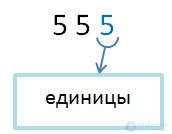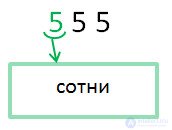Lecture
To write numbers, people came up with ten characters, which are called numbers. These are: 0, 1, 2, 3, 4, 5, 6, 7, 8, 9.
With the help of ten digits you can write any natural number.
The number of characters (digits) in the number depends on its name.
A number consisting of a single digit (digit) is called a single digit. The smallest single-digit natural number is 1, the largest is 9.
A number consisting of two characters (numbers) is called a two-digit number. The smallest two-digit number is 10, the largest is 99.
Numbers written with two, three, four, or more digits are called two-digit, three-digit, four-digit, or multi-digit. The smallest three-digit number is 100, the largest is 999.
Each digit in the record of a multi-digit number takes a certain place - a position.
The discharge is the place (position) on which there is a number in the record of the number.
The same digit in the record of a number can have different values depending on what level it stands in.
Discharges are counted from the end of the number.
The unit one is the lowest level with which any number ends.
The number 5 - means 5 units, if the top five is in the last place in the record number (in units).

The tens digit is the digit that faces the discharge of units.
The number 5 - means 5 dozen if it is in the penultimate place (in the tens level).

The discharge of hundreds is the discharge that stands before the discharge of tens. The number 5 means 5 hundred, if it is on the third place from the end of the number (in the discharge of hundreds).

If there is no digit in the number, then in the record of the number in its place there will be the digit 0 (zero).
Example. The number 807 contains 8 hundreds, 0 dozen and 7 units - such a record is called the bit composition of the number .
807 = 8 hundred 0 dozen 7 unitsEvery 10 units of any category form a new unit of a higher category. For example, 10 units form 1 dozen, and 10 dozen form 1 hundred.
Thus, the value of the digit from discharge to discharge (from units to tens, from tens to hundreds) increases 10 times. Therefore, the counting system, which we use, is called the decimal number system.
In writing the number of digits, starting from the right, are grouped into classes of three digits in each.
The class of units or the first class is the class that is formed by the first three digits (to the right of the end of the number): the digit of the units, the digit of tens, and the digit of hundreds .
Example.
| Numbers | Class of units (first class) | ||
|---|---|---|---|
| hundreds | tens | units | |
| 6 | - | - | 6 |
| 34 | - | 3 | four |
| 148 | one | four | eight |
The class of thousands or the second class is the class that consists of the following three categories: units of thousands, tens of thousands and hundreds of thousands.
Example.
| Numbers | Class thousand (second class) | Class of units (first class) | ||||
|---|---|---|---|---|---|---|
| hundreds of thousands | tens of thousands | units of thousands | hundreds | tens | units | |
| 5234 | - | - | five | 2 | 3 | four |
| 12,803 | - | one | 2 | eight | 0 | 3 |
| 356,149 | 3 | five | 6 | one | four | 9 |
We remind you that 10 units of hundreds of units (from a class of units) form one thousand (unit of the next category: unit of thousands in the class of thousands).
10 hundred = 1 thousandThe class of millions or the third class is the class that consists of the following three categories: units of millions, tens of millions and hundreds of millions.
The unit of one million is one million or one thousand thousand (1000 thousand). One million can be written as 1,000,000.
Ten such units form a new bit unit — ten million (10,000,000).
Ten tens of millions form a new bit unit — one hundred million, or in the record in digits of 100,000,000.
Example.
| Numbers | Class of millions (third class) | Class thousand (second class) | Class of units (first class) | ||||||
|---|---|---|---|---|---|---|---|---|---|
| hundreds of millions | tens of millions | units of millions | hundreds of thousands | tens of thousands | units of thousands | hundreds | tens | units | |
| 8 345 216 | - | - | eight | 3 | four | five | 2 | one | 6 |
| 93 785 342 | - | 9 | 3 | 7 | eight | five | 3 | four | 2 |
| 134 590 720 | one | 3 | four | five | 9 | 0 | 7 | 2 | 0 |
To read a multi-digit number, you need to name the number of units of each class in turn from left to right and add the class name.
Do not pronounce the name of the class of units, as well as the name of the class, all three digits of which are zeros.
For example, the number 134,590,720 read: one hundred thirty-four million five hundred ninety thousand seven hundred twenty.
The number 418 000 547 we read: four hundred eighteen million five hundred forty-seven.
To make it easier to remember how to read and write multi-digit numbers, we recommend using the above “Tables of classes and categories”.
Comments
To leave a comment
Arithmetic
Terms: Arithmetic